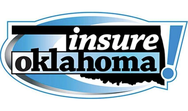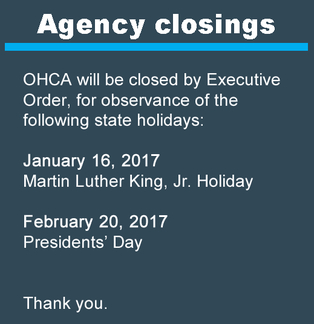|
Winter 2017


The second round of OHCA's proposed rules will be available for comment at www.okhca.org/PolicyBlog on Jan. 18, 2017. Proposed permanent rules may include proposals for new programs and/or policies or amendments to current policies. They also include rules previously promulgated on an emergency basis.
Permanent rule recommendations go to the Legislature and Governor for action in the spring.
We encourage you to review the proposed rules and give your input. The OHCA online proposed rule change site provides a forum for proposed rule changes and seeks advice from constituents and the general public. All comments are considered during the process and become a part of the official record.
The comment period for the first round of proposed rule changes closes on Jan. 15, 2017.
Please here for more details on our rulemaking process.
Back to top
|

 |
|
Six provider types have contracts set to expire on March 31, 2017 - audiologist, hospital, inpatient psychiatric facility, Indian/tribal/urban – primary care provider (ITU – PCP), optician and optometrist. However, these providers can start renewing their contracts now. Please log on to the secure OHCA Provider Portal to get started.
Back to top
|

You and your staff are invited to attend the spring 2017 SoonerCare Provider Training Workshops hosted by OHCA and HP Enterprise Services.
- Lawton April 13
- Durant April 27
- Tulsa May 17 - 18
- OKC May 24 - 25
- Guymon June 21
OHCA and HP highly recommend that all providers attend a workshop in their area. Be sure to mark your calendar!
Watch for class descriptions, recommended audiences and registration details in the next Provider Checkup (March). Updates will also post to the provider training page of our website.
Back to top


Important: Provider fingerprinting requirement
All state Medicaid agencies must require contracted providers to consent to criminal background checks. These security checks include fingerprinting providers who are considered high-risk - DME and home health providers fall into this category. This requirement is part of the enhanced screening provisions contained in Section 640 of the Affordable Care Act. (42 CFR §455.434)
The OHCA must obtain fingerprints from anyone with a 5 percent or more direct or indirect ownership interest. Therefore, if you are a DME or home health provider, your business will need to be fingerprinted. Providers enrolled by Medicare may be exempt from this requirement.
For additional information or instruction, please call 800-522-0114, option 5, and ask to speak to OHCA Provider Enrollment. If you prefer to email, you can send your inquiries to ProviderEnrollment@okhca.org.
Back to top
|


Pharmacy reimbursement reminder
Pharmacy claims are now reimbursed through a new pricing methodology to reflect changes in federal regulations. This change impacts reimbursement rates for all pharmacy providers and went into effect on Jan. 3, 2017.
Learn more about this new pricing rule here.
|
New year brings new tier changes
New step therapy tier changes went into effect on Jan. 1, 2017, for the following drug classes:
- Antidepressants
- Antihypertensives
- Anti-migraine medications
- Antiplatelet medications
- Asthma and Chronic Obstructive Pulmonary Disease (COPD) medications
- Atypical antipsychotic medications
- Bladder control medications
- Diabetic medications
- Glaucoma medications
- Opioid addiction medications (buprenorphine/naloxone)
- Pediculicides
- Stimulant medications
Complete tier lists and prior authorization criteria is available on our website at www.okhca.org/pa.

Opioids in Pregnancy
Pregnant women with chronic pain diagnoses present a unique challenge for providers. It is estimated that as many as 85 percent of pregnant women use some type of medication during pregnancy, with pain medications being the most common after vitamins and supplements.1
A report from the Centers for Disease Control and Prevention (CDC) reviewed opioid claims among women of reproductive age between 2008 and 2012 and found that approximately 39 percent of Medicaid-enrolled women and 28 percent of women with private insurance filled a prescription for an opioid from an outpatient pharmacy each year.2 This higher frequency of opioid prescribing to Medicaid-enrolled women is important to note due to approximately 50 percent of U.S. births, and 62 percent of Oklahoma births occurring to Medicaid-enrolled women.3
The U.S. Food and Drug Administration (FDA) has released several safety communications regarding opioid pain medications. In 2013, the FDA released a boxed warning on all extended-release and long-acting (ER/LA) opioid analgesics intended to treat pain, advising that chronic maternal use of these products during pregnancy can result in neonatal opioid withdrawal syndrome also known as neonatal abstinence syndrome (NAS).4 NAS symptoms include the following:
⦁ dehydration
⦁ excessive crying
⦁ diarrhea
⦁ increased muscle tone
⦁ hyperreflexia
⦁ fever
⦁ congestion
⦁ diaphoresis
⦁ irritability
⦁ difficulty sleeping or seizures
|
These symptoms can occur one to 10 days after birth.5 In 2016, this boxed warning was then added to all immediate-release opioid pain medications.6 Due to the nature of this special population, data is limited as to the safety of use and potential effects on birth outcomes.
NAS occurs in approximately 5.6 percent of opioid-exposed neonates.7 From 2000 to 2009, the rate of maternal opioid use increased five-fold, and the rate of NAS increased three-fold.8 A large population-based control study also found an association between maternal therapeutic use of opioids in early pregnancy and several types heart conditions, such as, conoventricular septal defect, atrioventricular septal defect, atrial septal defect, hypoplastic left heart syndrome, tetralogy of Fallot, and pulmonary valve stenosis. It is important to note that some of these defects are important contributors to increased infant morbidity and mortality. This same study also noted that there was a significant association between spina bifida and maternal opioid use one month before and three months after conception.9
 |
Opioid pain medications are used to treat a variety of conditions in pregnant women covered by Medicaid. One study found that among Medicaid-enrolled pregnant women who received an opioid prescription, the most common diagnoses were abdominal pain (48.4 percent), lower back pain (33 percent), headache (13.3 percent), joint pain (11 percent), or migraine (8 percent). The CDC reported the most commonly used opioids in Medicaid-enrolled pregnant women between 2008 and 2012 were hydrocodone (25 percent), codeine (9.4 percent), and oxycodone (13 percent).
For pregnant women experiencing pain that requires pharmacologic treatment, acetaminophen is considered first-line.10 However, opioid pain medications remain an important option for pregnant patients. Several agencies and organizations offer guidance for prescribers using opioid medications for their patients during pregnancy and the post-partum period:
If an opioid pain medication is appropriate, it is important to counsel the patient on the potential risks of using opioids during pregnancy, especially if the opioid is for chronic use. Patients and providers are encouraged to report any incidences of side effects to the FDA MedWatch program at http://www.fda.gov/safety/medwatch/default.htm.
References
- Pritham UA and McKay L. Safe Management of Chronic Pain in Pregnancy in an Era of Opioid Misuse and Abuse. JOGNN 2014; 43:544-567.
- Ailes EC, Dawson AL, Lind JN, et al. Opioid Prescription Claims Among Women of Reproductive Age – United States, 2008-2012. MMWR 2015; 64(02):37-41.
- SoonerCare Delivery Fast Facts. SFY 2016. https://okhca.org/research.aspx?id=87 . Accessed December 12, 2016.
- FDA announces safety labeling changes and postmarket study requirements for extended-release and long-acting opioid analgesics [news release]. Silver Springs, MD: Food and Drug Administration; 2013. http://www.fda.gov/NewsEvents/Newsroom/PressAnnoucements/ucm367726.htm. Accessed November 11, 2016.
- Kellog A, Rose CH, Harms RH, et al. Current trends in narcotic use in pregnancy and neonatal outcomes. Am J Obstet Gynecol. 2011; 204:259.e1-4.
- FDA announces enhanced warnings for immediate-release opioid pain medications related to risks of misuse, abuse, addiction, overdose and death [news release]. Silver Springs, MD: Food and Drug Administration; 2016. http://www.fda.gov/newsevents/newsroom/pressannoucements/ucm491739.htm. Accessed October 24, 2016.
- Kellogg A, Rose CH, Harms RH, et al. Current trends in narcotic use in pregnancy and neonatal outcomes. Am J Obstet Gynecol 2011; 204:259.e1-4.
- Patrick SW, Schumacher RE, Benneyworth BD, et al. Neonatal Abstinence Syndrome and Associated Health Care Expenditures: United States, 2000-2009. JAMA. 2012; 307(18): 1394-1940.
- Broussard CS, Rasmussen SA, Reefhuis J, et al. Maternal treatment with opioid analgesics and risk for birth defects. Am J Obstet Gynecol 2011; 204:314.e1-11.
- Shah S, Banh ET, Koury K, et al. Pain Management in Pregnancy: Multimodal Approaches. Pain Research and Treatment 2015; 2015: Article ID: 987483.
Back to top


Let’s chat about dental health
Oral health is important to overall health, and now is a great time to chat with your pediatric patients about their teeth.
February is National Children's Dental Health Month and provides an opportunity for the medical and dental communities to work together to improve the health of our children. Medical providers can ask when the child last saw a dentist and can refer him or her to a SoonerCare dental provider; dentists can reach out to members who are not current on their periodic exams.
In addition, OHCA has some helpful tip sheets to aid in caring for children's teeth. You can download them at no cost here. We encourage you to use them while promoting the benefits of the SoonerCare dental program to caretakers of our pediatric members (under age 21).
Simple conversation may help create sparkling smiles for a lifetime. Talk to them today!
|
Statewide event offers free dental services in February
Get ready for the Oklahoma Mission of Mercy (OkMOM) event, February 3-4, 2017, at the Woodward County Fairgrounds & Event Center. OkMOM is a two-day, FREE dental clinic for adults and children who are either uninsured, under-insured or would normally not have access to dental care. No-cost dental screenings help these patients identify their needs and determine a treatment plan.
This annual event provides dental care to as many people as time, volunteers and supplies will allow. To donate or for more information, please visit OkMOM online at http://www.okmom.org/.
Since 2010, OkMOM has treated 12,175 patients, totaling $8,742,959 in donated dental care.
This event is endorsed by the Oklahoma State Department of Health.
Back to top


A quick look at lead poisoning prevention
There is no safe level of lead, and children under age six are most vulnerable to lead poisoning. Children are at risk for lead poisoning from exposure to lead-based paint in older homes, imported toys, makeup, jewelry, lead glaze on pottery and dishware, and many other common items they may come in contact with during their day.
The Center for Medicaid & CHIP Services (CMCS) requires that all children enrolled in Medicaid undergo blood lead testing at 12 months of age and again at 24 months. In addition, any child who has failed to do so at their 12 and 24-month EPSDT visits must have at least one blood lead test prior to reaching age 6.
A confirmatory venous blood lead test is necessary to confirm any elevated finger stick (capillary) blood lead result. For children with elevated blood lead levels, it is important to ask questions of the parents regarding the child’s environment and other potential sources of lead exposure. Remember to screen other children living in the same household if one child has a confirmed elevated blood lead test.
Anticipatory Guidance for Parents:
- Encourage parents to model good handwashing techniques for their children, to help them avoid ingesting lead dust and to prevent other illnesses.
- Parents who live in homes built prior to 1978 should practice good housekeeping and clean using wet methods such as damp towels and wet mops. This helps not to stir up lead dust.
- Only certified professionals should attempt to remove lead-based paint. Incorrect removal of lead-based paint can spread lead dust and other hazards throughout the entire home.
- According to the Centers for Disease Control and Prevention (CDC), parents should ensure that children eat nutritious meals rich in iron, calcium and vitamin C. Doing so can decrease lead absorption.
Prevention is key when it comes to lead poisoning. If you have any questions or concerns, or would like additional information, please contact the Oklahoma Childhood Lead Poisoning Prevention Program (OCLPPP) at the Oklahoma State Department of Health: 405-271-6617.
Remember, if you are using a point-of-care lead testing device (such as Lead Care II), you are required to report ALL testing results to OCLPPP.
Back to top
|

Nutritional services available for your patients
SoonerFit.org is a free online resource to help Oklahomans get fit and stay well. This OHCA-operated website also connects SoonerCare members to nutritional and child health services that may be covered under their health plans.
Did you know that adults and children can have up to six hours of nutritional counseling per year by a licensed registered dietician? It’s true, but these services must be prescribed by a physician, physician assistant, advanced practice nurse or nurse midwife. We encourage our medical home providers to discuss this option with members when deemed medically necessary.
Please note: Qualifications for the SoonerCare nutritional services benefit differ slightly for adults, kids, pregnant women and waivered services. For specific benefit and payment details, click here. For questions or more information, please contact your SoonerCare provider representative at 800-522-0114.
Back to top
|


Continued federal funding
The OHCA has secured federal funding for Insure Oklahoma's 2017 operations. Click here to read Gov. Mary Fallin's announcement.
Insure Oklahoma assists those who might otherwise go without medical care. By participating in the Insure Oklahoma program small businesses owners, employees and their spouses may enjoy more affordable premiums. When combining their insurance plan with Insure Oklahoma, small businesses can save up to 60 percent on health care coverage costs for eligible employees.
Back to top
|
 |


Passed during the 2nd regular session of the 55th Legislature, House Bill 2962 (HB 2962), authored by Representative Jason Nelson and Senator AJ Griffin, directs the OHCA and partnering state agencies Oklahoma Department of Mental Health and Substance Abuse Services (ODMHSAS), Oklahoma State Department of Education (OSDE), and the Oklahoma State Department of Health (OSDH) to study and prepare a report concentrating on the use of applied behavior analysis (ABA) therapy treatment for children with autism spectrum disorder (ASD) within SoonerCare, the state’s Medicaid program.
Over the course of six months, the interagency workgroup developed a comprehensive report examining the current landscape of treatment options available to ASD children through state services, the medical evidence behind ABA treatment, services offered by other states and the fiscal impact to Oklahoma if ABA treatment is included as a covered SoonerCare benefit. This report was submitted to the governor and the Oklahoma State Legislature at the end of December 2016.
Please click here to view.
Back to top
|

On Nov. 30, 2016, the Oklahoma Office of Management and Enterprise Services released the request for proposal (RFP) for SoonerHealth+, the fully capitated, statewide model of care coordination that is being developed for Oklahoma Medicaid’s aged, blind and disabled (ABD) population.
The RFP was issued at the directive of state leadership whom approved House Bill 1566 during the 2015 session, requesting OHCA to initiate the proposal process. The legislation’s intent is to provide ABD members with better access to care, improved quality and health outcomes, as well as controlled costs by utilizing a care coordination model.
OHCA follows state of Oklahoma and national procurement guidelines. Currently, OHCA is in the midst of a silent period, which will last until the end of the six-month procurement period. OHCA staff members are not allowed to speak on the RFP or the process during this time.
OHCA has suspended stakeholder meetings and public presentations on SoonerHealth+ activities for the duration of the procurement period. Questions will only be accepted using the official question process that can be found in section 3.3 of the RFP under the “Submission of Questions” heading.
The RFP can be found at www.okhca.org/about.aspx?id=3217 (OHCA).
Proposals can be submitted until Feb. 28, 2017. The procurement period is scheduled to end in June of 2017. Stakeholders are encouraged to visit www.okhca.org/abdcarecoordination to sign up for Web Alerts to receive the latest information on the SoonerHealth+ effort.
Back to top
|

OHCA Provider Helpline: 800-522-0114
|